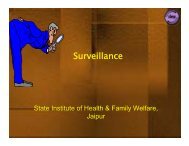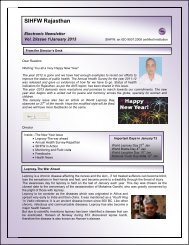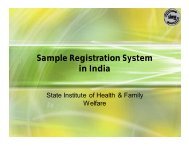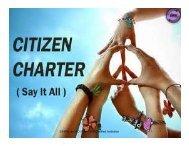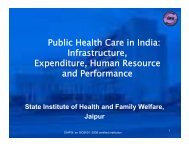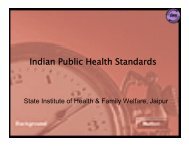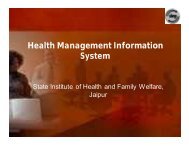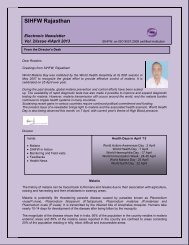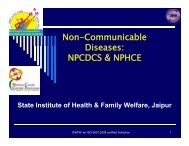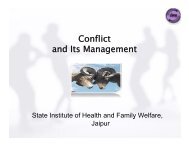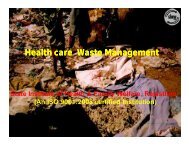Health Management Information Health ... - SIHFW Rajasthan
Health Management Information Health ... - SIHFW Rajasthan
Health Management Information Health ... - SIHFW Rajasthan
Create successful ePaper yourself
Turn your PDF publications into a flip-book with our unique Google optimized e-Paper software.
<strong>Health</strong> <strong>Management</strong> <strong>Information</strong><br />
System<br />
State Institute of <strong>Health</strong> and Family Welfare,<br />
Jaipur
Basic Definitions<br />
Data<br />
“Messages not evaluated for their worth<br />
in specific situations”<br />
Primary<br />
Secondary<br />
<strong>Information</strong><br />
“Evaluated data”<br />
“A resource with cost & benefit<br />
“Potential knowledge”<br />
“An essential input for decision making<br />
<strong>SIHFW</strong> : an ISO 9001:2008 certified institution 2
Record<br />
“A document of transaction between a client and<br />
service provider containing details of who did<br />
what to whom, when and where” , eg e.g.<br />
A bill<br />
A prescription<br />
A discharge ticket<br />
A laboratory report<br />
A register<br />
<strong>SIHFW</strong> : an ISO 9001:2008 certified institution 3
<strong>Information</strong> System<br />
“Comprehensive, coherent arrangement<br />
organized on an organizational or major<br />
program basis to collect, process and<br />
provide coordinated information to<br />
serve multiple needs of management<br />
system”<br />
<strong>SIHFW</strong> : an ISO 9001:2008 certified institution 4
Data Triangulation<br />
i<br />
The synthesis and integration of data<br />
from multiple sources through<br />
collection, examination, comparison and<br />
interpretation<br />
<strong>SIHFW</strong> : an ISO 9001:2008 certified institution 5
12 Step Approach to Triangulation<br />
Planning for triangulation<br />
1.Brainstorm questions<br />
2.Identify questions that are important,<br />
actionable, answerable and appropriate for<br />
triangulation<br />
3.Identify data sources and gather background<br />
information<br />
4.Refine the investigation question(s)<br />
Conducting triangulation<br />
5.Gather data/reports<br />
6.Make observations <strong>SIHFW</strong> : an ISO 9001:2008 from certified each institutiondata-set<br />
6
12 Step Approach to Triangulation<br />
7. Note trends across datasets and hypothesize<br />
e<br />
8. Check (corroborate, refute, modify)<br />
hypotheses<br />
9. Identify additional data source(s) and return to<br />
step 5<br />
10. Summarize findings and draw conclusions<br />
11. Communicate the results and<br />
recommendations<br />
12. Outline next steps based on findings<br />
<strong>SIHFW</strong> : an ISO 9001:2008 certified institution 7
Characteristics of Data Sources<br />
for Triangulation<br />
1. Programmatic data<br />
2. Biological data (surveys)<br />
3. Behavioural data<br />
<strong>SIHFW</strong> : an ISO 9001:2008 certified institution 8
<strong>Health</strong> <strong>Information</strong> System<br />
“an integrated effort to<br />
• collect,<br />
• process,<br />
• report and<br />
• use health information & knowledge for<br />
• influencing<br />
•policy-making,<br />
• program action, and<br />
• research.<br />
<strong>SIHFW</strong> : an ISO 9001:2008 certified institution 9
M.I.S. <br />
A two directional characteristic of information flow,<br />
with systematically y designed arrangement to -<br />
‣ Generate<br />
‣ Collect<br />
‣ Analyze<br />
‣ Store<br />
‣ Present<br />
‣ Make available<br />
required information to different managerial levels<br />
for improved and timely decisions and actions<br />
<strong>SIHFW</strong> : an ISO 9001:2008 certified institution 10
Definition<br />
‣ MIS is a system having a combination of<br />
‣ persons,<br />
‣ a set of manuals, and<br />
‣ certain equipments to<br />
‣select,<br />
‣store,process and<br />
‣retrieve data to -<br />
reduce the uncertainty in decision making by<br />
yielding information to managers at the time<br />
they can most efficiently use it.<br />
<strong>SIHFW</strong> : an ISO 9001:2008 certified institution 11
Essential Features of <strong>Information</strong><br />
System<br />
‣ Reliable<br />
‣ Not too much paper work<br />
‣ Data transmission - accurate and timely<br />
‣ Availability in disaggregated form<br />
‣ Shortest time lag between collection and<br />
transmission<br />
‣ Data must be available to assess both<br />
quantity and quality of health care<br />
‣ Simple- recording reporting and analysis<br />
<strong>SIHFW</strong> : an ISO 9001:2008 certified institution 12
Service Statistics v/s MIS<br />
‣ Service statistics- generate data<br />
‣ MIS -utilization of data in the planning<br />
and control activities, in an organization<br />
<strong>SIHFW</strong> : an ISO 9001:2008 certified institution 13
<strong>Information</strong> in <strong>Health</strong> Care Delivery:<br />
Why<br />
‣ Evidence based policy and strategic<br />
decision-making<br />
‣ Program management<br />
‣ Monitoring the process and outcomes<br />
‣ Evaluation of achievements<br />
<strong>SIHFW</strong> : an ISO 9001:2008 certified institution 14
HMIS- Need<br />
‣ Increasing utilization<br />
‣ Increasing client satisfaction<br />
‣ Increasing health status<br />
‣ Induction of manpower<br />
‣ Problem solving<br />
‣ Resource allocation<br />
‣ Rewards / Promotions<br />
‣ (at times for Fault finding)<br />
<strong>SIHFW</strong> : an ISO 9001:2008 certified institution 15
HMIS: Objectives<br />
• Strategic planning<br />
• Disease surveillance systems<br />
• Use of ICD-10<br />
• National health database<br />
• Technical support to strengthen data<br />
analysis<br />
• Research<br />
• Use of scientific evidence based on<br />
research<br />
<strong>SIHFW</strong> : an ISO 9001:2008 certified institution 16
Other Objectives<br />
• Medical care-<br />
– Quality assurance &<br />
– Assessment of outcome<br />
• Cost control & productivity enhancement<br />
• Utilization analysis and demand estimation<br />
• Program planning & evaluation<br />
• Simplification of Records<br />
• Education<br />
• Clinical research<br />
<strong>SIHFW</strong> : an ISO 9001:2008 certified institution 17
Sources of Data<br />
‣ Diaries<br />
‣ Family registers<br />
‣ Hospital registers / Records<br />
‣ Periodic reports<br />
‣ Rapid surveys<br />
‣ Exit interviews<br />
‣ National sample survey<br />
‣ Census<br />
‣ Special studies<br />
<strong>SIHFW</strong> : an ISO 9001:2008 certified institution 18
Data :Attributes<br />
‣ Accurate<br />
‣ Valid<br />
‣ Reliable<br />
‣ Timely<br />
‣ Complete<br />
‣ Retrievable<br />
<strong>SIHFW</strong> : an ISO 9001:2008 certified institution 19
Collection of Data:<br />
Data Collection Tools<br />
‣Reporting Formats<br />
‣Online reporting<br />
‣Eligible g Couple Survey<br />
‣Concurrent Evaluation/ Studies<br />
‣Survey by different Agencies<br />
‣Monitoring and Validation Exercise<br />
<strong>SIHFW</strong> : an ISO 9001:2008 certified institution 20
Data Requirements at Different<br />
Levels of Decision i Making<br />
……Top level….<br />
Quality<br />
Quantity<br />
….Middle level….<br />
….Lower level….<br />
l<br />
<strong>SIHFW</strong> : an ISO 9001:2008 certified institution 21
<strong>Health</strong> information Tools for<br />
Different ee Levels eesof the <strong>Health</strong> eat System<br />
Out tbreak Sur rveillance<br />
Ce ensuses<br />
Vital Registratio n<br />
SRS<br />
Surv veys<br />
HMIS<br />
Modeling<br />
&<br />
estimates s<br />
Communities<br />
Global<br />
Regions<br />
Countries<br />
Provinces<br />
Districts<br />
Facilities<br />
<strong>SIHFW</strong> : an ISO 9001:2008 certified institution 22
<strong>Health</strong><br />
determinants<br />
Risk factors<br />
Behaviors<br />
Genetics<br />
Environment<br />
<strong>Health</strong> status<br />
Socio-<br />
economic &<br />
demographic<br />
<strong>Health</strong><br />
systems<br />
outcomes<br />
Mortality<br />
Morbidity/<br />
disability<br />
<strong>Health</strong><br />
systems<br />
inputs<br />
<strong>Health</strong><br />
systems<br />
outputs<br />
Service<br />
utilization<br />
Well-being<br />
Policy<br />
Financing<br />
Human<br />
resources<br />
Organization<br />
<strong>Information</strong><br />
Service<br />
availability &<br />
quality<br />
<strong>SIHFW</strong> : an ISO 9001:2008 certified institution 23
Attributes of HMIS<br />
‣Timeliness<br />
‣Accuracy<br />
‣Relevance<br />
‣Up-to-datednessd d<br />
‣Adequacy<br />
‣No Overloading<br />
‣Format Clarity<br />
‣No duplication<br />
‣Explicitness<br />
it<br />
<strong>SIHFW</strong> : an ISO 9001:2008 certified institution 24
Strengths of HMIS<br />
‣ In streamlining and standardizing of data records.<br />
‣ In creation of an integrated warehouse<br />
‣ In collecting data from different sources<br />
‣ Conducting cross analysis.<br />
‣ Rationalizing of reporting flows<br />
‣ Supporting customized reporting.<br />
‣ Indicator based analysis.<br />
‣ Integration of various software applications such<br />
as GIS and Excel.<br />
‣ Conducting data quality validation.<br />
<strong>SIHFW</strong> : an ISO 9001:2008 certified institution 25
‣ HMIS does not offer<br />
“Ready - made” solution<br />
‣ Each HMIS is<br />
“Tailor made” specific to an<br />
organization and levels within it<br />
<strong>SIHFW</strong> : an ISO 9001:2008 certified institution 26
HMIS- Issue<br />
‣ Is there a policy existing for <strong>Health</strong> <strong>Information</strong><br />
system<br />
‣ Does an organizational structure exist at the<br />
National level for HMIS<br />
‣ Functional linkages between sub-systems<br />
‣ Capacity building-potential, activities and<br />
resources<br />
<strong>SIHFW</strong> : an ISO 9001:2008 certified institution 27
‣ Is there a Fixed- frequency review of<br />
reports and records<br />
‣ How are reports made and who makes<br />
them<br />
‣ Is there a built in system for checking<br />
reliability of data generated at the lowest<br />
level l <br />
<strong>SIHFW</strong> : an ISO 9001:2008 certified institution 28
HMIS- Purpose<br />
Planning<br />
Implementation<br />
ti Needed for<br />
Monitoring<br />
<strong>Information</strong><br />
Evaluation<br />
Purpose<br />
• Monitoring<br />
• Control<br />
- Cost<br />
-Time<br />
-Resources<br />
<strong>SIHFW</strong> : an ISO 9001:2008 certified institution 29
HMIS-Application<br />
should Provide Support to-<br />
‣ <strong>Health</strong> Workers:<br />
‣Understand health needs<br />
‣Prioritizing clients<br />
‣Estimate requirement<br />
‣ Program Mangers:<br />
‣Assess quality & Coverage<br />
‣Allocate resources<br />
‣Reduce wastage and<br />
duplication<br />
<strong>SIHFW</strong> : an ISO 9001:2008 certified institution 30
‣Policy Makers:<br />
‣Assess cost-effectiveness<br />
‣Decide content & mode of<br />
service delivery<br />
‣Develop norms<br />
‣Financial<br />
‣Infrastructure<br />
‣Staffing<br />
‣Logistics<br />
<strong>SIHFW</strong> : an ISO 9001:2008 certified institution 31
Prerequisites of HMIS<br />
‣ Existing formats, transmission system &<br />
channels, capacity of data handlers and<br />
analyzers and the resources (hard and<br />
soft) available.<br />
‣ Exploring possibilities of additions and<br />
deletion of parameters<br />
‣ Complimentary or contradictory nature of<br />
sub-systems of the System<br />
<strong>SIHFW</strong> : an ISO 9001:2008 certified institution 32
Components -Basic <strong>Management</strong><br />
Process<br />
5 components of the basic mgt. process in healthcare-<br />
1. Establishing goals & Objective<br />
2. Estimate demand for services<br />
3. Allocate resources including manpower to<br />
meet demands<br />
4. Control quality<br />
5. Evaluate performance<br />
<strong>SIHFW</strong> : an ISO 9001:2008 certified institution 33
Establishing Goals & Objective<br />
• Problem indicators<br />
»Mortality<br />
»morbidity<br />
»Social indicators<br />
»Economic data<br />
»<strong>Health</strong> seeking behavior<br />
• Data on services delivered by other<br />
community organizations<br />
• Resources available<br />
<strong>SIHFW</strong> : an ISO 9001:2008 certified institution 34
Estimate Demand for Services<br />
• Data on utilization<br />
• Demographic data<br />
• Community projections<br />
<strong>SIHFW</strong> : an ISO 9001:2008 certified institution 35
Allocate Resources<br />
• Data on work force<br />
• Financial information<br />
• Capital requirements<br />
• Short term demand forecasts<br />
<strong>SIHFW</strong> : an ISO 9001:2008 certified institution 36
Control Quality<br />
• Output measure<br />
• Quality control data<br />
• Work sampling & measurement<br />
• Medical audit<br />
<strong>SIHFW</strong> : an ISO 9001:2008 certified institution 37
Evaluate Performance<br />
• Changes in problem indicators<br />
• Cost benefit analysis<br />
• Changes in community’s capability<br />
to provide services<br />
<strong>SIHFW</strong> : an ISO 9001:2008 certified institution 38
HMIS- Components<br />
‣ Identification<br />
‣ Collection<br />
‣ Classification<br />
‣ Processing<br />
‣ Communication<br />
‣ Interpretation<br />
‣ Storage<br />
‣ Retrieval<br />
<strong>SIHFW</strong> : an ISO 9001:2008 certified institution 39
Factors Required to Develop and<br />
Implement HMIS:<br />
‣ Strong political backing<br />
‣ A culture that values and uses information<br />
‣ Involving all levels in changes to HMIS<br />
‣ Starting with improving the paper based<br />
system<br />
‣ Ensuring the feedback loop is continuous<br />
and reliable<br />
<strong>SIHFW</strong> : an ISO 9001:2008 certified institution 40
Levels at Which We Need <strong>Information</strong><br />
‣ Point of entry of client into the System<br />
‣ Point of Service<br />
‣ Point of decision-making<br />
<strong>SIHFW</strong> : an ISO 9001:2008 certified institution 41
Use of <strong>Information</strong><br />
‣ National & State Ministries for<br />
‣Assessing impact<br />
‣Policy y development<br />
‣Financial allocations<br />
‣ <strong>Health</strong> care professionals for<br />
‣Treatment in Hospitals/ CHC/ PHC<br />
‣Choosing i alternatives ti between care<br />
lines<br />
<strong>SIHFW</strong> : an ISO 9001:2008 certified institution 42
‣ Legal bodies<br />
‣As documentary evidence of care<br />
‣Protect interests of <strong>Health</strong> care<br />
professionals and patients<br />
‣ Insurance companies for reimbursement of<br />
claims<br />
<strong>SIHFW</strong> : an ISO 9001:2008 certified institution 43
<strong>Information</strong> in <strong>Health</strong> Planning<br />
• <strong>Information</strong> for assessing need<br />
• <strong>Information</strong> for controlling utilization and<br />
standards (quality of services)<br />
• <strong>Information</strong> for controlling deployment of<br />
resources<br />
• <strong>Information</strong> for increasing effectiveness of<br />
services<br />
<strong>SIHFW</strong> : an ISO 9001:2008 certified institution 44
HMIS- Designing<br />
Technical Requirements<br />
‣ Data collection instrument<br />
‣Simple<br />
‣Minimum<br />
‣ Develop a data flow mechanism<br />
‣Who generate<br />
‣Who consolidate<br />
‣Whom to be sent & How (mode)<br />
‣Where & by whom to be analyzed<br />
‣Whom to be reported<br />
‣Frequency q y of compilation, Analysis &<br />
reporting<br />
<strong>SIHFW</strong> : an ISO 9001:2008 certified institution 45
Basic steps in Designing HMIS<br />
‣ Determine organizational need for<br />
information<br />
‣ Identify sources of information<br />
‣ Decide on amount, form and frequency<br />
‣ Select means of information communication<br />
& processing<br />
<strong>SIHFW</strong> : an ISO 9001:2008 certified institution 46
HMIS- Designing <strong>Information</strong> System<br />
‣What data is needed<br />
‣Who generates in what form<br />
‣Quality<br />
‣Processing g requirement<br />
‣Types of formats for<br />
reporting<br />
‣Frequency of reporting<br />
‣Data storage system<br />
‣Devices for storage<br />
‣What should be the channel<br />
for info. flow<br />
Steps<br />
‣Determine<br />
organizational need for<br />
information<br />
‣Identify sources of<br />
information<br />
‣Decide on amount,<br />
form and frequency<br />
‣Select means of<br />
information<br />
communication &<br />
processing<br />
<strong>SIHFW</strong> : an ISO 9001:2008 certified institution 47
Designing i HMIS<br />
1. Design Requirements:<br />
‣Clarity of Objectives<br />
‣Awareness of information need<br />
‣Flexibility to change<br />
<strong>SIHFW</strong> : an ISO 9001:2008 certified institution 48
2. Considerations in information system design<br />
‣Identifying & listing of objectives and norms<br />
‣Identification of all decision points<br />
‣Determination of relative importance & priority of<br />
identified decisions<br />
‣Identifying information need for decision<br />
‣Identification of relationship among decision sets<br />
‣Specification of information system<br />
‣Installation<br />
‣Establishing g a review mechanism<br />
<strong>SIHFW</strong> : an ISO 9001:2008 certified institution 49
3. <strong>Information</strong> requirements - governed by<br />
‣Decision ecso structure ucueof Program oga<br />
‣Levels of decision making<br />
‣Questions to be answered<br />
‣Economics of information management, based<br />
on these requirements decision shall be taken<br />
regarding type of information, which could be-<br />
‣Scientific& Technical (Related to problem<br />
& solution<br />
‣Situational (Program environment)<br />
‣Programmatic (Intervention system)<br />
<strong>SIHFW</strong> : an ISO 9001:2008 certified institution 50
HMIS- Process<br />
Formulated information<br />
(fixed)<br />
Constraining Planning Execution<br />
<strong>Information</strong><br />
(Dynamic)<br />
Processed<br />
information<br />
(Dynamic)<br />
Monitoring & Control<br />
Reports Processing Reports<br />
inputs<br />
Storage<br />
<strong>SIHFW</strong> : an ISO 9001:2008 certified institution 51
Analyze the Data:<br />
‣By y allotted ELA/Targets<br />
‣By comparison of last year progress<br />
‣By health indicators<br />
‣By annual action plan<br />
‣By Five Year plans<br />
<strong>SIHFW</strong> : an ISO 9001:2008 certified institution 52
HMIS- Problem Areas<br />
‣ Unrealistic expectation of Managers<br />
‣ Addressing to –”Report to higher levels”<br />
rather than convincing of benefits<br />
‣ Too much information asked<br />
‣ Poorly trained, Over worked staff, (30-40 %<br />
time in reporting)<br />
‣ <strong>Information</strong>-selective & to handle out of<br />
pressure ad hoc exigencies<br />
‣ Many reporting levels- Data lost<br />
<strong>SIHFW</strong> : an ISO 9001:2008 certified institution 53
‣ Performance indicators<br />
‣Shifting gpriorities within program<br />
‣New additions- NO deletions<br />
‣ Indicators- simply pyoutput oriented<br />
‣ Program priorities & timeliness of information<br />
flow<br />
‣ Retrieval<br />
‣ Duplication<br />
‣ NO periodic review<br />
‣ NO feed back to initiate corrective measures<br />
<strong>SIHFW</strong> : an ISO 9001:2008 certified institution 54
‣ Decision makers to:<br />
HMIS Supports<br />
‣Detect and control emerging and endemic<br />
health problems<br />
‣Monitor progress towards health goals,<br />
‣Promote equity<br />
‣ Empowering individuals and communities with<br />
‣Timely and understandable health-related<br />
information<br />
‣Drive improvements in quality of services<br />
<strong>SIHFW</strong> : an ISO 9001:2008 certified institution 55
‣ Supports <strong>Health</strong> Workers, in<br />
‣ Understand health needs (based on<br />
approaches like CNAA)<br />
‣ Prioritizing clients (Estimate requirements<br />
(based on Demographic profile, morbidity<br />
profile, coverage and /or Expectations)<br />
‣ Support Program Mangers, for<br />
‣ Assessing quality & Coverage<br />
‣ Allocating resources<br />
‣ Reducing wastage and duplication<br />
<strong>SIHFW</strong> : an ISO 9001:2008 certified institution 56
‣ Support Policy makers, to<br />
‣Assess cost-effectiveness<br />
‣Decide content & mode of service delivery<br />
‣Develop norms:<br />
‣Financial<br />
‣Infrastructure<br />
‣Staffing<br />
‣Logistics<br />
<strong>SIHFW</strong> : an ISO 9001:2008 certified institution 57
Reporting Formats under NRHM<br />
Institutions<br />
Reporting Format<br />
Sub centre Form No. 6<br />
PHC Form No. 7<br />
CHC/FRU/UFWC Form No. 8<br />
Block level<br />
Form No. 9 A<br />
District level Form No. 9<br />
<strong>SIHFW</strong> : an ISO 9001:2008 certified institution 58
Thank You<br />
For more details log on to<br />
www.sihfwrajasthan.com<br />
or<br />
contact : Director-<strong>SIHFW</strong> on<br />
sihfwraj@yahoo.co.in



